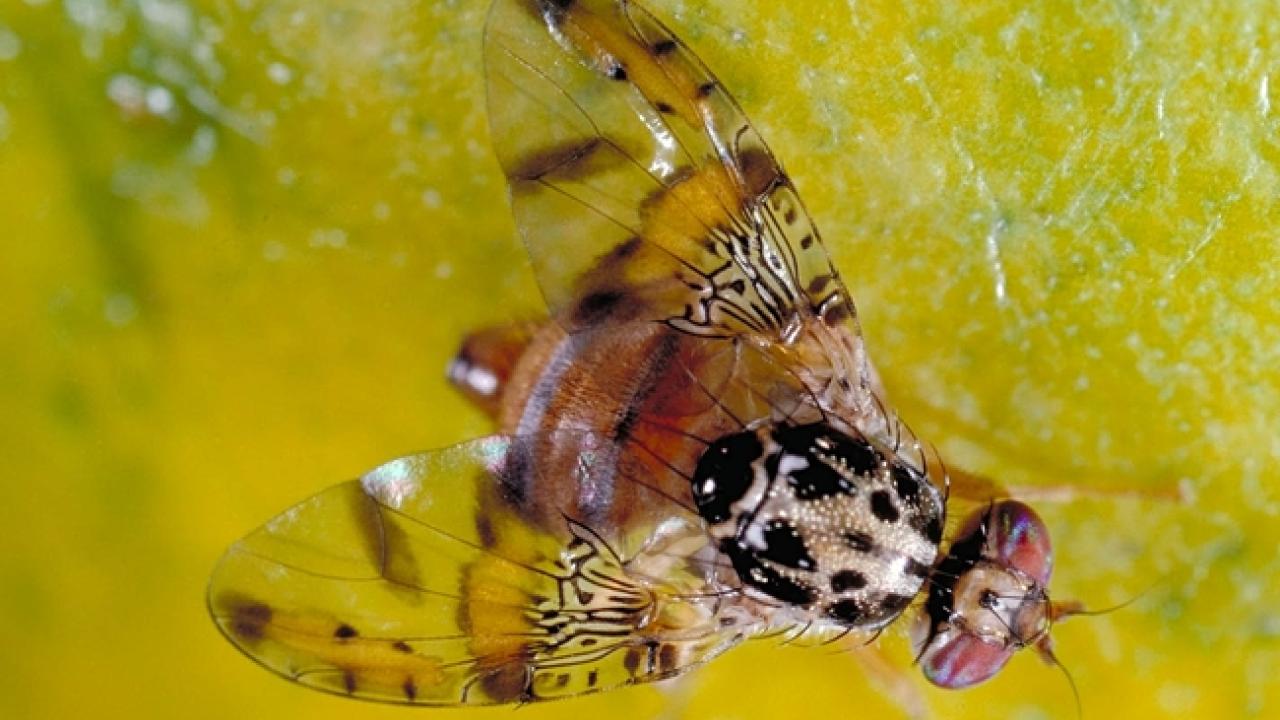
James R. Carey: 'California's Fruit Fly Invasion Crisis'
Seminar Set for 4:10 p.m., Monday, June 3

(See June 3rd presentation on YouTube at:
https://www.youtube.com/watch?v=pa2eHuvPLHQ)
California's fruit fly invasion is in crisis mode, says UC Davis distinguished professor James R. Carey, a noted authority on the invasion of tropical fruit flies.
Professor Carey will present a Department of Entomology and Nematology seminar on "California's Fruit Fly Invasion Crisis" at 4:10 p.m., Monday, June 3 in Room 122 of Briggs Hall. It also will be on Zoom. The Zoom link:
https://ucdavis.zoom.us/j/9 5882849672.
This is the last seminar of the spring quarter.
"After seven decades of near-continuous outbreaks in scores of California cities, tephritid fruit fly invasions (e.g., Mediterranean, oriental, peach, and Mexican fruit flies) are reaching critical mass, with many of the annual eradication programs morphing into below-the-radar, never-ending fruit fly control programs," Carey says in his abstract. "Permanent establishment of any one of these tropical species has the potential to shut down the multi-billion dollar domestic and foreign markets for hundreds of California fruit and vegetable crops."
"I will present an overview of the long-developing crisis, discuss lessons learned from analysis of fruit fly detection databases, and argue that, in order to have any chance at stemming this ever-rising tide, CDFA (California Department of Food and Agriculture) and the USDA (U.S. Department of Agriculture) urgently needs to switch from their historic, ad hoc eradication strategy to a new one that is evidence-based and far more scientific."
Carey served on the CDFA's Medfly Scientific Advisory Panel from 1987-1994, testified to the California Legislature "Committee of the Whole" in 1990 on the Medfly Crisis in California, and authored the paper "Establishment of the Mediterranean Fruit Fly in California" (1991, Science 258, 457).
From Trickle to Flood
Eleven years ago (April 2013), he delivered a seminar to the Department of Entomology and Nematology on "From Trickle to Flood: The Large-Scale, Cryptic Invasion of California by Tropical Fruit Flies."
"Despite aggressive and costly efforts by government agencies to prevent their introduction, establishment and spread, California has experienced an inexorable march of tropical fruit flies (Tephritidae) into the state with three-fold more species detected and thousands more flies captured than in all other mainland U.S. states combined," Carey related in his 2013 abstract.
"Since 1954 when the first fly was detected, a total of 17 species in 4 genera and 11,386 individuals (adults/larvae) have been detected at over 3,348 locations in 330 cities," he told the 2013 seminar attendees. "My colleagues and I conclude from spatial mapping analyses of historical capture patterns and modeling that, despite the approximately 250 emergency eradication projects that have been directed against these pests by state and federal agencies, a minimum of 5 and as many as 9 or more tephritids are established and widespread. This list includes three of the most economically-important species in the world—the Mediterranean, Mexican and oriental fruit flies."
Carey is a senior scholar in the Center for the Economics and Demography of Aging at UC Berkeley and former vice chair of the UC Davis Department of Entomology. He focuses his research on insect biodemography, mortality dynamics, and insect invasion biology. He joined the Department of Entomology in 1980.
Fellow of 4 Professional Societies
Carey is a fellow of four professional societies: the Entomological Society of America, the American Association for the Advancement of Science, the California Academy of Sciences, and the Gerontological Society of America. He is former director (2003-13) of a 11-university consortium funded by the National Institute on Aging (NIH/P01) on the evolutionary ecology of lifespan.
He co-authored the book Biodemography: An Introduction to Concepts and Methods (Carey, J. R. and D. Roach. 2020; Princeton University Press) and authored three previous books, Demography for Biologists (Oxford University Press 1993), Longevity (Princeton University Press, 2003), and Longevity Records: Life Spans of Mammals, Birds, Amphibians and Reptiles (Odense, 2000). He has written more than 250 journal articles and book chapters.
Carey teaches an upper division undergraduate course titled "Longevity" fall quarter and summer session that is based on biodemographic concepts in both non-human species and humans. He also offers seminars and workshops on best practices in visualization concepts and presentation strategies including a week course every year to PhD fellows in Kampala, Uganda enrolled in the 9-university Consortium for Advanced Research Training in Africa (CARTA).
For any technical issues with Zoom, contact seminar coordinator Brian Johnson, associate
professor, at brnjohnson@ucdavis.edu.
Resources:
- The 30‐Year Debate on a Multi‐Billion‐Dollar Threat: Tephritid Fruit Fly Establishment in California, June 8, 2017, American Entomologist
- Behind the Scenes in the California Fruit Fly Invasion, Aug. 6, 2013, UC Davis Department of Entomology and Nematology
- From a Trickle to a Flood: The Large-Scale Cryptic Invasion of California by Tropical Fruit Flies, October 2013, Proceedings of the Royal Society B
- Establishment of the Mediterranean Fruit Fly in California, 1991, Science
The UC Davis Department of Entomology and Nematology is ranked third among “The Best Entomology Colleges in the United States for 2024" by universities.com. The department includes 24 active and 19 retired faculty; 28 graduate students (five in the master's degree program and 23 in the doctoral degree program); 47 undergraduate entomology majors (based on the Office of Academic Support and Instructional Services (OASIS) Student Reports); and a staff comprised of 27 academics (non-faculty), 24 career, and 56 student assistants. Professor and chair of the department is molecular geneticist and physiologist Joanna Chiu. Community ecologist Rachel Vannette, associate professor, serves as the vice chair.
